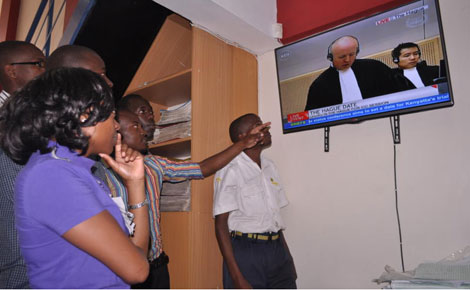 |
|
Kisumu residents following proceedings at the International Criminal Court on television. [PHOTOS: FILE/ STANDARD] |
With a salary of Sh10,000, Dennis Omweno, a waiter in Nairobi says he cannot afford to pay any more bill, no less for television, which he has been getting for free all along.
A father of two, Omweno’s first born is in Standard One in an ‘academy’, his rent is Sh4,000 plus bus fare amounting to Sh3,000 per month.
“And they have to eat,” interjects his colleague Brian Ogillo, at the African Taste Restaurant on Muindi Mbingu Street, Nairobi.
“Hii pay TV sio ya mahustlers (this pay TV is not for hustlers) ,” adds Ogillo.
The two reflect the feeling of many Kenyans in the wake of the Communications Authority of Kenya’s (CAK) decision to withdraw digital frequencies of the country’s leading broadcasters KTN, NTV/QTV and Citizen televisions. Operating under the Africa Digital Network, the three media houses got the frequencies from CAK after a protracted legal battle.
Even with the frequencies offered, theirs was a raw deal. The Chinese firm, Pan African Network Group which owns Star Times was awarded 120 frequencies out of the 211 frequencies issued, which is close to 60 per cent of national digital spectrum. The Kenya Broadcasting Corporation (KBC) under its affiliate Signet, was allocated 53 frequencies while KTN, NTV and Citizen TV, who control 80 per cent of viewership were jointly allocated 21 frequencies.
But the frequencies have been withdrawn. This is not good news to most Kenyans who are sure they will not access Pay TV come the global analogue switch off on June 17.
“I always thought I will buy a one off decoder, without paying monthly subscriptions,” says Isaac Mbuki, a boda boda operator based near the Jeevanjee Gardens. He earns slightly higher than Ogillo and Omweno, about Sh1,000 on a good day translating to Sh30,000 monthly.
From this, he pays rent of Sh5,000, has to pay school fees for his six-year-old daughter among other utilities.
“Not mentioning 'kanju' (the County Council askaris) who harass us, and the traffic police who regularly charge us. I feel it is not fair that I have to pay monthly television subscriptions.”
Not far from Mbuki along Moi Avenue at the Sports Solutions Exhibition, we meet Faith Mutua and Judy Nyaboke. Faith, a mother of one, says that recently, she went to buy a television set and was given the option of a digital television. “That way, I will not need to buy a set-top box.”
However, she has noticed that the free -to-air stations offered in the digital television are not as comprehensive as she would love. The digital television comes with a slot for a smart card, which again is supposed to be sold by the pay televisions. But they are not stocking them saying they are not compatible with the TVs in the markets.
“I do not need any more expenses,” says Faith, echoing her colleague Judy. They both take home about Sh20,000, of which a sizeable amount goes to rent and basic utilities, power and water.
But these, in a way are ‘lucky few’ in that they at least earn. Majority of Kenyans cannot even afford a television set, leave alone monthly subscriptions.
A look at the recently launched Social –Economic Atlas of Kenya, Depicting the National Population Census by County and Sub- Location and based on the 2009 Kenya Population and Housing Census, shows the number of Kenyan households who own a television set was 28 per cent or 2.5 million households.
Stay informed. Subscribe to our newsletter
The number is larger in urban areas, with Nairobi leading with 62 per cent followed by Kiambu with 55 per cent and Mombasa 49 per cent. Mandera has the lowest, 1.6 per cent, Wajir at 2.5 and Turkana three per cent.
According to the survey released by the Ministry of Devolution and Planning, television ownership, apart from economic factors is also determined by the access to electricity.
In 2009, almost two million households or 22.7 per cent or one in four households used electricity for lighting. For now, according to CAK, only 1.2 million set top boxes have been sold since digital migration started in Kenya. The Director General Francis Wangusi, adds that there are additional 1.5million set boxes in stock. If sold, this will translate to 3.7 million Kenyans able to access digital television.
The number might increase as we near June 17, 2015, the date set by the International Telecommunication Union. But even so, majority of Kenyans will be left without television as was witnessed in Tanzania.
Tanzania was the first country in sub-Saharan Africa to switch off the analogue signal starting off with Dar es Salaam on December 31, 2012. It was estimated that half of television owners in Dar es Salaam were left without television as they had not purchased the set top boxes due to inability to afford the cost.
But as Standard Group’s Digital Editor David Ohito says, Kenya will be converted from free-to-air television viewership to a compulsory pay-to-watch TV society, despite the big number of people who are vulnerable and live in poverty and cannot afford subscription fees.
Our interviewees above echo this feeling. Ogillo, the assistant supervisor at the African Taste Restaurant says, “we hear KTN, Citizen, NTV will go to court to challenge CAK’s decision. We pray that Paul Muite, mtetezi wa wanyonge (poor man’s advocate) will win this case.”
Well, senior counsel Paul Muite, the lead counsel for the Africa Digital Network has written to Attorney General Githu Muigai concerning the violation of intellectual property rights of the said Media houses.
In the letter, Muite shows that the “must carry principal” which authorise Pay TV companies like GOTV and Startimes to carry the Free-to-Air Channels of the three media houses, will not give poor Kenyan’s access to free broadcasting as it is purported.
“Nothing could be further from the reality,” he writes, “... there is a manifest intention to “kill” the free to air television businesses of the three major media houses in favour of pay television media houses, which are foreign owned.”
This, he says, is piracy of media content. The content, programmes and shows on television cost the free to air stations a lot of money to produce, though they do not sell it like the pay television stations, but rather rely on advertising.
However, the pay television stations, under the present set-up, are using free-to-air television’s content without paying for it or seeking consent from the local media houses.
“This would not be permitted anywhere else in the world,” writes Muite. Ironically, the must carry principal was borrowed from United States, where the scenario is the opposite.
Being a developed nation, majority could afford and were on pay TV with only a small population unable to afford and relying on free to air. Thus, the regulation for the Pay TV stations to include Free to Air was introduced but subject with their request and consent.
Even as Muite says his client, ADN, will seek justice through the World Intellectual Property Organisation treaty, the man on the street wants to be assured that their right to information will be protected come June 17.
 The Standard Group Plc is a
multi-media organization with investments in media platforms spanning newspaper
print operations, television, radio broadcasting, digital and online services. The
Standard Group is recognized as a leading multi-media house in Kenya with a key
influence in matters of national and international interest.
The Standard Group Plc is a
multi-media organization with investments in media platforms spanning newspaper
print operations, television, radio broadcasting, digital and online services. The
Standard Group is recognized as a leading multi-media house in Kenya with a key
influence in matters of national and international interest.
 The Standard Group Plc is a
multi-media organization with investments in media platforms spanning newspaper
print operations, television, radio broadcasting, digital and online services. The
Standard Group is recognized as a leading multi-media house in Kenya with a key
influence in matters of national and international interest.
The Standard Group Plc is a
multi-media organization with investments in media platforms spanning newspaper
print operations, television, radio broadcasting, digital and online services. The
Standard Group is recognized as a leading multi-media house in Kenya with a key
influence in matters of national and international interest.






